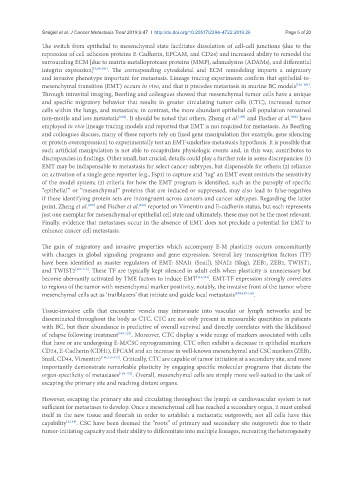Page 340 - Read Online
P. 340
Smigiel et al. J Cancer Metastasis Treat 2019;5:47 I http://dx.doi.org/10.20517/2394-4722.2019.26 Page 5 of 20
The switch from epithelial to mesenchymal state facilitates dissolution of cell-cell junctions (due to the
repression of cell adhesion proteins E-Cadherin, EPCAM, and CD24) and increased ability to remodel the
surrounding ECM [due to matrix-metalloprotease proteins (MMP), adamalysins (ADAMs), and differential
integrin expression] [3,96-101] . The corresponding cytoskeletal and ECM remodeling imparts a migratory
and invasive phenotype important for metastasis. Lineage tracing experiments confirm that epithelial-to-
mesenchymal transition (EMT) occurs in vivo, and that it precedes metastasis in murine BC models [102-104] .
Through intravital imaging, Beerling and colleagues showed that mesenchymal tumor cells have a unique
and specific migratory behavior that results in greater circulating tumor cells (CTC), increased tumor
cells within the lungs, and metastasis; in contrast, the more abundant epithelial cell population remained
non-motile and less metastatic . It should be noted that others, Zheng et al. and Fischer et al. have
[105]
[106]
[104]
employed in vivo lineage tracing models and reported that EMT is not required for metastasis. As Beerling
and colleagues discuss, many of these reports rely on fixed gene manipulation (for example, gene silencing
or protein overexpression) to experimentally test an EMT-underlies-metastasis hypothesis. It is possible that
such artificial manipulation is not able to recapitulate physiologic events and, in this way, contributes to
discrepancies in findings. Other small, but crucial, details could play a further role in some discrepancies: (1)
EMT may be indispensable to metastasis for select cancer subtypes, but dispensable for others; (2) reliance
on activation of a single gene reporter (e.g., Fsp1) to capture and "tag" an EMT event restricts the sensitivity
of the model system; (3) criteria for how the EMT program is identified, such as the panoply of specific
“epithelial” or “mesenchymal” proteins that are induced or suppressed, may also lead to false-negatives
if these identifying protein sets are incongruent across cancers and cancer subtypes. Regarding the latter
point, Zheng et al. and Fischer et al. reported on Vimentin and E-cadherin status, but each represents
[106]
[105]
just one exemplar for mesenchymal or epithelial cell state and ultimately, these may not be the most relevant.
Finally, evidence that metastases occur in the absence of EMT does not preclude a potential for EMT to
enhance cancer cell metastasis.
The gain of migratory and invasive properties which accompany E-M plasticity occurs concomitantly
with changes in global signaling programs and gene expression. Several key transcription factors (TF)
have been identified as master regulators of EMT: SNAI1 (Snail), SNAI2 (Slug), ZEB1, ZEB2, TWIST1,
and TWIST2 [107-112] . These TF are typically kept silenced in adult cells when plasticity is unnecessary but
become aberrantly activated by TME factors to induce EMT [113,114] . EMT-TF expression strongly correlates
to regions of the tumor with mesenchymal marker positivity, notably, the invasive front of the tumor where
mesenchymal cells act as ‘trailblazers’ that initiate and guide local metastasis [108,115-118] .
Tissue-invasive cells that encounter vessels may intravasate into vascular or lymph networks and be
disseminated throughout the body as CTC. CTC are not only present in measurable quantities in patients
with BC, but their abundance is predictive of overall survival and directly correlates with the likelihood
of relapse following treatment [119-123] . Moreover, CTC display a wide range of markers associated with cells
that have or are undergoing E-M/CSC reprogramming. CTC often exhibit a decrease in epithelial markers
CD24, E-Cadherin (CDH1), EPCAM and an increase in well-known mesenchymal and CSC markers (ZEB1,
Snail, CD44, Vimentin) [116,124-127] . Critically, CTC are capable of tumor initiation at a secondary site, and more
importantly demonstrate remarkable plasticity by engaging specific molecular programs that dictate the
organ-specificity of metastases [128-133] . Overall, mesenchymal cells are simply more well-suited to the task of
escaping the primary site and reaching distant organs.
However, escaping the primary site and circulating throughout the lymph or cardiovascular system is not
sufficient for metastases to develop. Once a mesenchymal cell has reached a secondary organ, it must embed
itself in the new tissue and flourish in order to establish a metastatic outgrowth; not all cells have this
capability [3,134] . CSC have been deemed the “roots” of primary and secondary site outgrowth due to their
tumor-initiating capacity and their ability to differentiate into multiple lineages, recreating the heterogeneity

